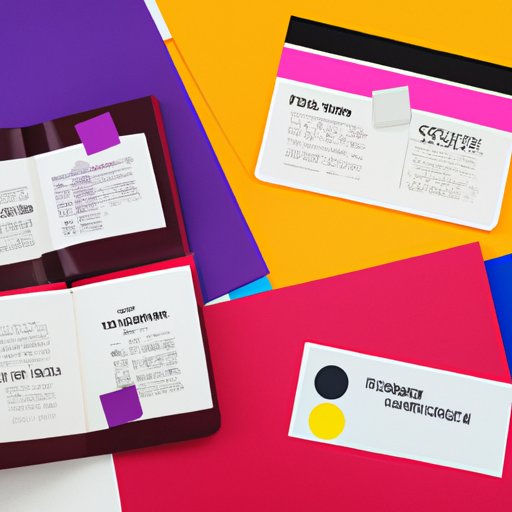
Introduction
Marketing collateral refers to any type of material used to promote a business or product, such as brochures, flyers, whitepapers, and case studies. As businesses compete for attention in a crowded marketplace, having effective marketing collateral is essential for driving brand awareness, boosting sales, and establishing credibility. In this article, we’ll explore the importance of marketing collateral for businesses, provide a comprehensive guide to creating effective content, examine the different types of marketing collateral, and provide tips for designing successful campaigns.
The Importance of Marketing Collateral in Boosting Your Brand’s Visibility
Marketing collateral plays a crucial role in boosting a brand’s visibility and increasing its recognition among potential customers. By creating compelling content that effectively communicates a brand’s value proposition, businesses can differentiate themselves from competitors and establish a strong presence in the marketplace. Successful marketing collateral campaigns can also capture attention, generate leads, and ultimately drive sales.
One example of a successful marketing collateral campaign is Nike’s “Just Do It” slogan, which has become synonymous with the brand’s identity and has helped establish Nike as a leader in the athletic apparel industry. Other successful campaigns include Coca-Cola’s “Share a Coke” campaign, which featured personalized labels with individual names and generated a 2% increase in global sales.

A Comprehensive Guide to Creating Effective Marketing Collateral
Effective marketing collateral contains several key elements that work together to create a compelling message. A strong message should be clear, concise, and focused on the target audience’s needs and desires. A well-designed layout with eye-catching visuals can enhance the message and grab attention. A clear call-to-action should be included to encourage the reader to take action, whether it’s visiting a website, contacting a sales representative, or making a purchase.
To create effective marketing collateral, businesses should first define their target audience, research their needs and preferences, and develop a clear understanding of their pain points and challenges the product or service can solve. Content should be designed with these factors in mind, creating a message that resonates with the target audience and speaks to their unique needs. A consistent brand identity should also be maintained across all marketing collateral to establish a strong and recognizable brand presence.
From Flyers to Whitepapers: Exploring the Different Types of Marketing Collateral
Marketing collateral comes in many different forms, each with its own strengths and weaknesses. Brochures are versatile and cost-effective but may not provide enough detail for complex products or services. Case studies can showcase real-world examples of successful implementations but may be too industry-specific for some audiences. Infographics can provide a visually engaging way to convey complex information but may require significant design expertise.
Other types of marketing collateral include flyers, whitepapers, product sheets, newsletters, and videos. Choosing the right type of collateral depends on the target audience, the nature of the product or service, and the intended message.
3 Benefits of Using Marketing Collateral to Enhance Your Business Sales
Effective marketing collateral can play a significant role in driving sales and generating revenue for a business. By creating a compelling message that speaks to a target audience’s needs and desires, businesses can differentiate themselves from competitors and establish a compelling value proposition that drives conversions.
One example of a successful marketing collateral campaign that drove sales is Airbnb’s Neighborhood Guides, which provided detailed information on local attractions and activities to potential customers. By providing valuable information and building trust with potential customers, Airbnb was able to increase bookings and generate revenue.
Designing Marketing Collateral: Tips and Tricks to Make Your Content Stand Out
Design is a critical component of creating effective marketing collateral. An eye-catching layout and strong visuals can capture attention and make the message more memorable. Businesses should focus on using images strategically, using white space to balance the layout, and creating a clear visual hierarchy to guide the reader’s attention. Calls-to-action should be prominently displayed, and the overall design should be consistent with the brand’s identity.
Some examples of effective marketing collateral designs include Apple’s minimalistic design aesthetic, which prioritizes simplicity and elegance, and Slack’s playful and engaging design, which features bright colors and cartoonish imagery.
Why Your Business Needs a Marketing Collateral Strategy
Having a cohesive strategy for creating and distributing marketing collateral is essential for maximizing its effectiveness. By developing a clear understanding of the target audience, defining the value proposition, and creating a consistent brand identity, businesses can create compelling content that resonates with potential customers and generates leads and sales.
Effective marketing collateral strategies should also consider distribution channels, such as social media, email marketing, and print advertising, and tailor the message to the specific audience and channel. By maximizing the reach and impact of marketing collateral, businesses can establish a strong brand presence and drive revenue growth.
How to Measure the Success of Your Marketing Collateral Campaigns: Metrics to Track
Measuring the effectiveness of marketing collateral campaigns is essential for identifying areas of improvement and maximizing return on investment. Some examples of metrics to track include click-through rates, conversion rates, social media engagement, and website traffic. By analyzing these metrics and making data-driven decisions, businesses can optimize their marketing collateral and improve its impact.
Conclusion
Marketing collateral is a critical element of any successful marketing strategy, providing businesses with the tools to increase brand visibility, drive sales, and establish credibility. By understanding the key elements of effective marketing collateral, exploring the different types of collateral available, and developing a cohesive strategy, businesses can create compelling content that resonates with potential customers and generates revenue. By implementing the tips and best practices outlined in this article, businesses can establish a strong brand presence and achieve their marketing goals.





